University IT Culture: SFIA, Ethics, and Professionalism Report
VerifiedAdded on 2021/06/14
|10
|2069
|52
Report
AI Summary
This report delves into the multifaceted aspects of professional IT culture, encompassing the Software Framework for Information Age (SFIA) and ethical considerations. The report is divided into two subtasks. The first subtask explores the SFIA framework, discussing its various levels and the responsibilities associated with each, with a focus on achieving higher competence levels. The second subtask presents a case study involving a company, Icvendor Pvy Ltd., and an ethical dilemma concerning faulty integrated circuits. The analysis includes the ethical dilemma faced by stakeholders, potential ethical responses, the application of the ACS code of professional conduct, and the consequences of failing to apply ethical decision-making. The report concludes by integrating theoretical frameworks, such as virtue ethics, deontology, and consequentialism, to offer a comprehensive understanding of the ethical challenges within the IT industry.
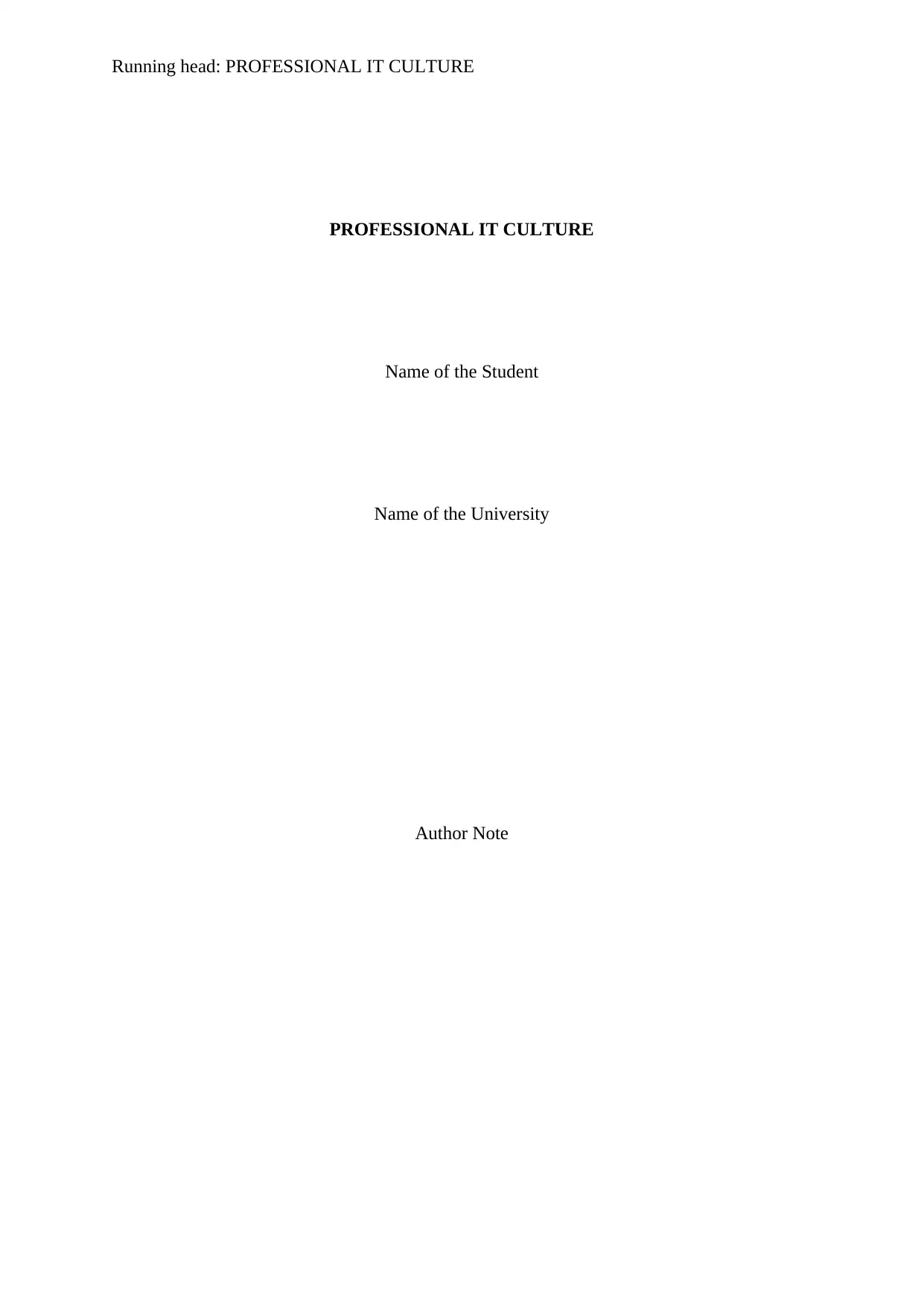
Running head: PROFESSIONAL IT CULTURE
PROFESSIONAL IT CULTURE
Name of the Student
Name of the University
Author Note
PROFESSIONAL IT CULTURE
Name of the Student
Name of the University
Author Note
Paraphrase This Document
Need a fresh take? Get an instant paraphrase of this document with our AI Paraphraser
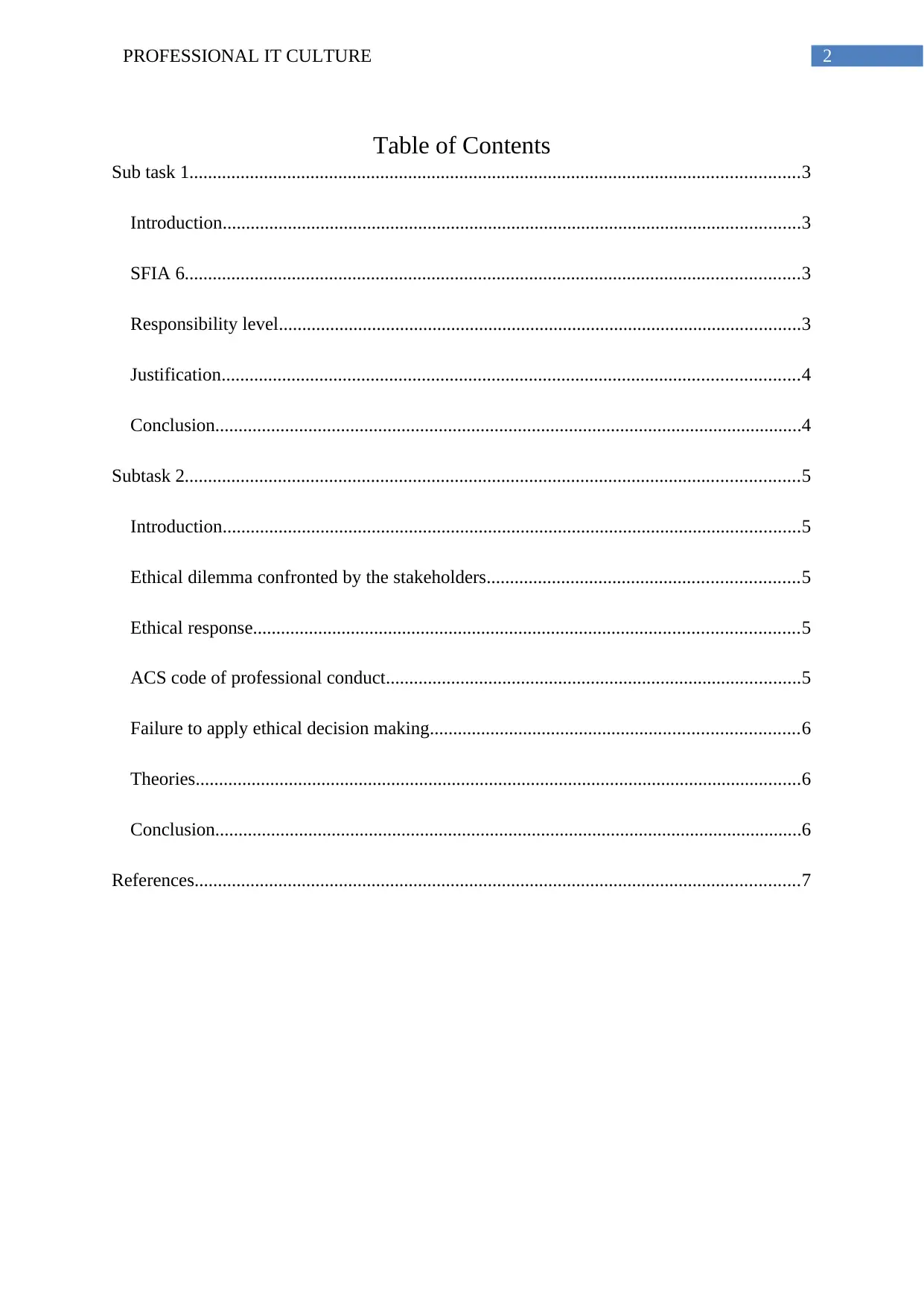
2PROFESSIONAL IT CULTURE
Table of Contents
Sub task 1...................................................................................................................................3
Introduction............................................................................................................................3
SFIA 6....................................................................................................................................3
Responsibility level................................................................................................................3
Justification............................................................................................................................4
Conclusion..............................................................................................................................4
Subtask 2....................................................................................................................................5
Introduction............................................................................................................................5
Ethical dilemma confronted by the stakeholders...................................................................5
Ethical response.....................................................................................................................5
ACS code of professional conduct.........................................................................................5
Failure to apply ethical decision making...............................................................................6
Theories..................................................................................................................................6
Conclusion..............................................................................................................................6
References..................................................................................................................................7
Table of Contents
Sub task 1...................................................................................................................................3
Introduction............................................................................................................................3
SFIA 6....................................................................................................................................3
Responsibility level................................................................................................................3
Justification............................................................................................................................4
Conclusion..............................................................................................................................4
Subtask 2....................................................................................................................................5
Introduction............................................................................................................................5
Ethical dilemma confronted by the stakeholders...................................................................5
Ethical response.....................................................................................................................5
ACS code of professional conduct.........................................................................................5
Failure to apply ethical decision making...............................................................................6
Theories..................................................................................................................................6
Conclusion..............................................................................................................................6
References..................................................................................................................................7
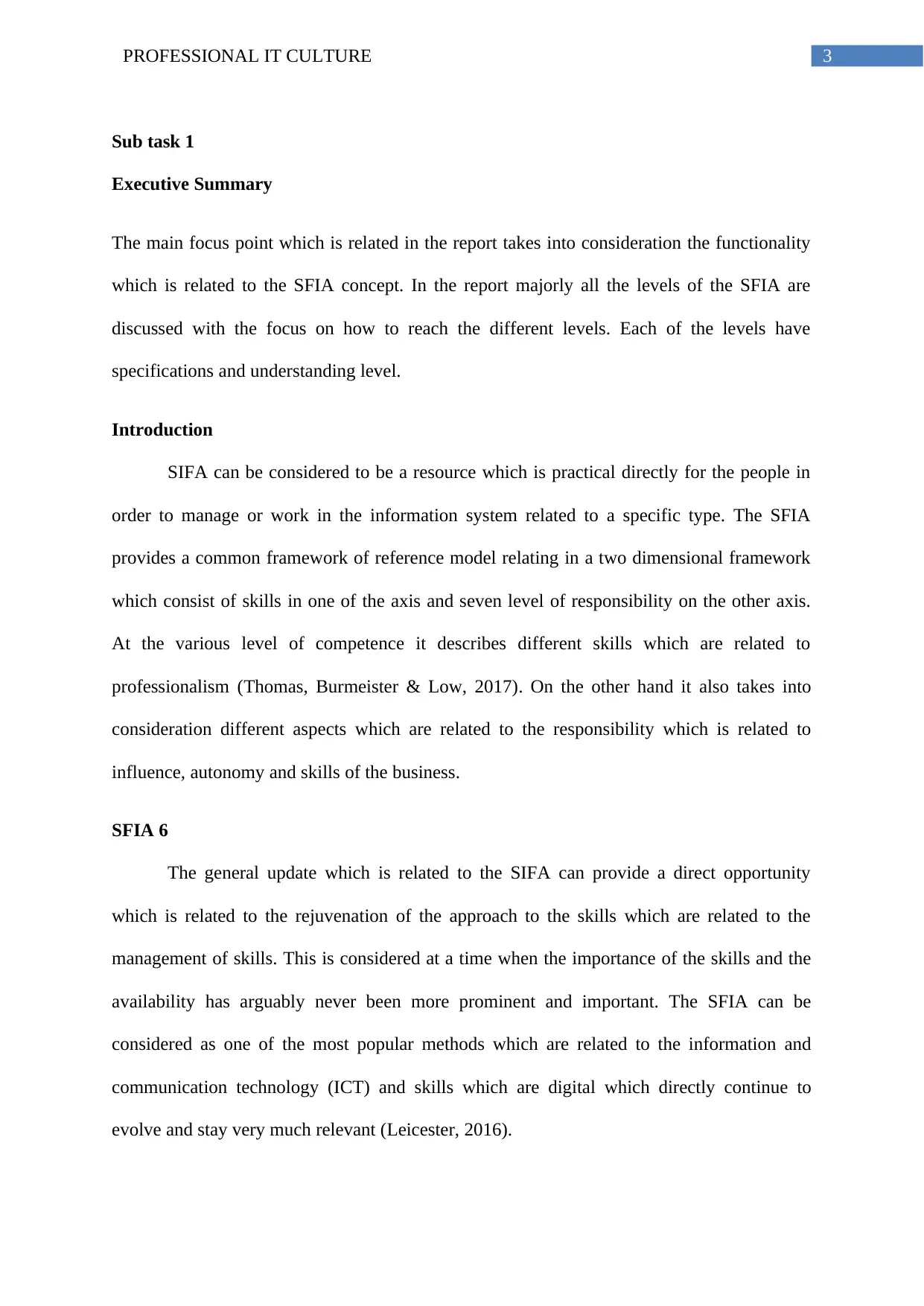
3PROFESSIONAL IT CULTURE
Sub task 1
Executive Summary
The main focus point which is related in the report takes into consideration the functionality
which is related to the SFIA concept. In the report majorly all the levels of the SFIA are
discussed with the focus on how to reach the different levels. Each of the levels have
specifications and understanding level.
Introduction
SIFA can be considered to be a resource which is practical directly for the people in
order to manage or work in the information system related to a specific type. The SFIA
provides a common framework of reference model relating in a two dimensional framework
which consist of skills in one of the axis and seven level of responsibility on the other axis.
At the various level of competence it describes different skills which are related to
professionalism (Thomas, Burmeister & Low, 2017). On the other hand it also takes into
consideration different aspects which are related to the responsibility which is related to
influence, autonomy and skills of the business.
SFIA 6
The general update which is related to the SIFA can provide a direct opportunity
which is related to the rejuvenation of the approach to the skills which are related to the
management of skills. This is considered at a time when the importance of the skills and the
availability has arguably never been more prominent and important. The SFIA can be
considered as one of the most popular methods which are related to the information and
communication technology (ICT) and skills which are digital which directly continue to
evolve and stay very much relevant (Leicester, 2016).
Sub task 1
Executive Summary
The main focus point which is related in the report takes into consideration the functionality
which is related to the SFIA concept. In the report majorly all the levels of the SFIA are
discussed with the focus on how to reach the different levels. Each of the levels have
specifications and understanding level.
Introduction
SIFA can be considered to be a resource which is practical directly for the people in
order to manage or work in the information system related to a specific type. The SFIA
provides a common framework of reference model relating in a two dimensional framework
which consist of skills in one of the axis and seven level of responsibility on the other axis.
At the various level of competence it describes different skills which are related to
professionalism (Thomas, Burmeister & Low, 2017). On the other hand it also takes into
consideration different aspects which are related to the responsibility which is related to
influence, autonomy and skills of the business.
SFIA 6
The general update which is related to the SIFA can provide a direct opportunity
which is related to the rejuvenation of the approach to the skills which are related to the
management of skills. This is considered at a time when the importance of the skills and the
availability has arguably never been more prominent and important. The SFIA can be
considered as one of the most popular methods which are related to the information and
communication technology (ICT) and skills which are digital which directly continue to
evolve and stay very much relevant (Leicester, 2016).
⊘ This is a preview!⊘
Do you want full access?
Subscribe today to unlock all pages.

Trusted by 1+ million students worldwide
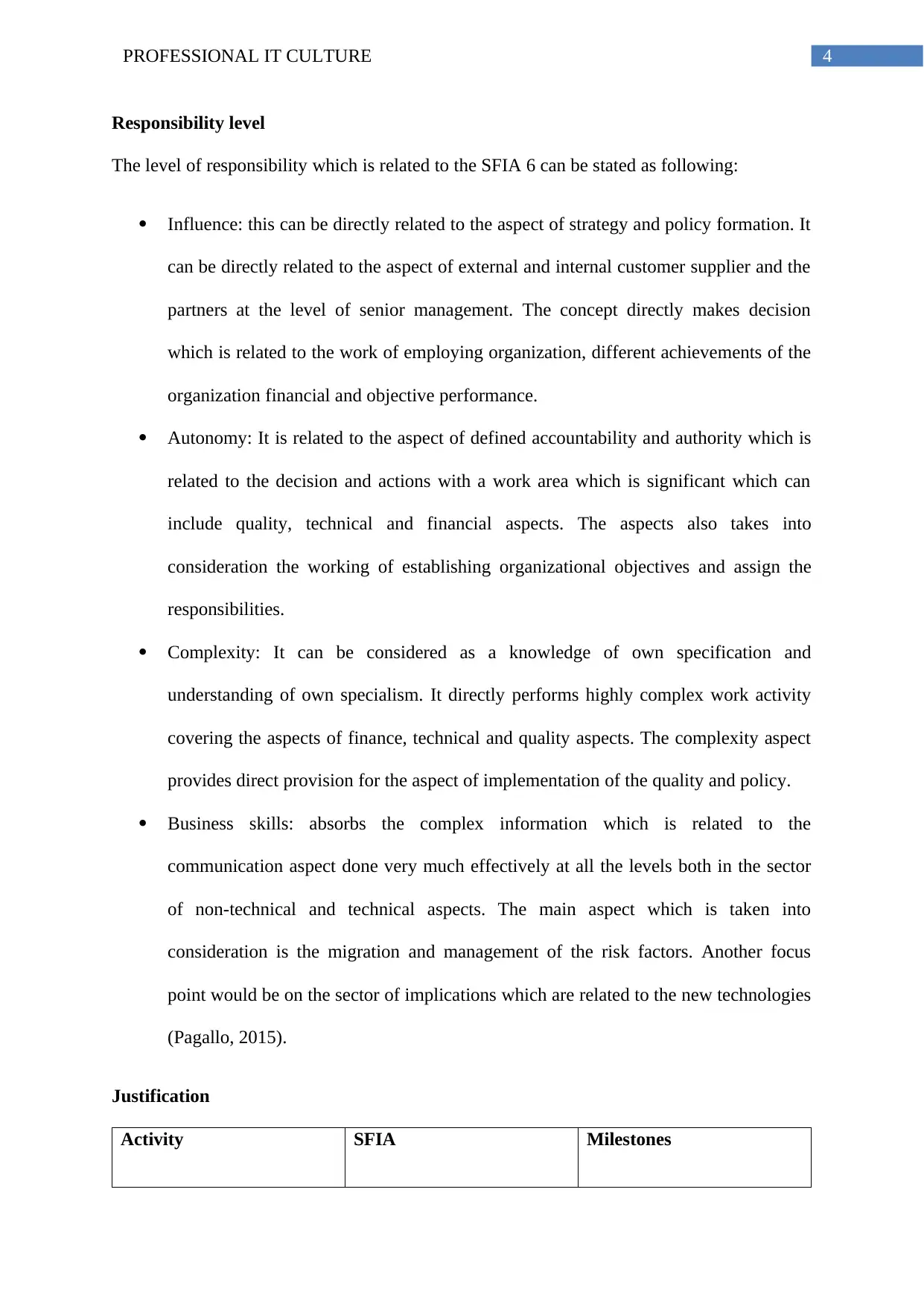
4PROFESSIONAL IT CULTURE
Responsibility level
The level of responsibility which is related to the SFIA 6 can be stated as following:
Influence: this can be directly related to the aspect of strategy and policy formation. It
can be directly related to the aspect of external and internal customer supplier and the
partners at the level of senior management. The concept directly makes decision
which is related to the work of employing organization, different achievements of the
organization financial and objective performance.
Autonomy: It is related to the aspect of defined accountability and authority which is
related to the decision and actions with a work area which is significant which can
include quality, technical and financial aspects. The aspects also takes into
consideration the working of establishing organizational objectives and assign the
responsibilities.
Complexity: It can be considered as a knowledge of own specification and
understanding of own specialism. It directly performs highly complex work activity
covering the aspects of finance, technical and quality aspects. The complexity aspect
provides direct provision for the aspect of implementation of the quality and policy.
Business skills: absorbs the complex information which is related to the
communication aspect done very much effectively at all the levels both in the sector
of non-technical and technical aspects. The main aspect which is taken into
consideration is the migration and management of the risk factors. Another focus
point would be on the sector of implications which are related to the new technologies
(Pagallo, 2015).
Justification
Activity SFIA Milestones
Responsibility level
The level of responsibility which is related to the SFIA 6 can be stated as following:
Influence: this can be directly related to the aspect of strategy and policy formation. It
can be directly related to the aspect of external and internal customer supplier and the
partners at the level of senior management. The concept directly makes decision
which is related to the work of employing organization, different achievements of the
organization financial and objective performance.
Autonomy: It is related to the aspect of defined accountability and authority which is
related to the decision and actions with a work area which is significant which can
include quality, technical and financial aspects. The aspects also takes into
consideration the working of establishing organizational objectives and assign the
responsibilities.
Complexity: It can be considered as a knowledge of own specification and
understanding of own specialism. It directly performs highly complex work activity
covering the aspects of finance, technical and quality aspects. The complexity aspect
provides direct provision for the aspect of implementation of the quality and policy.
Business skills: absorbs the complex information which is related to the
communication aspect done very much effectively at all the levels both in the sector
of non-technical and technical aspects. The main aspect which is taken into
consideration is the migration and management of the risk factors. Another focus
point would be on the sector of implications which are related to the new technologies
(Pagallo, 2015).
Justification
Activity SFIA Milestones
Paraphrase This Document
Need a fresh take? Get an instant paraphrase of this document with our AI Paraphraser
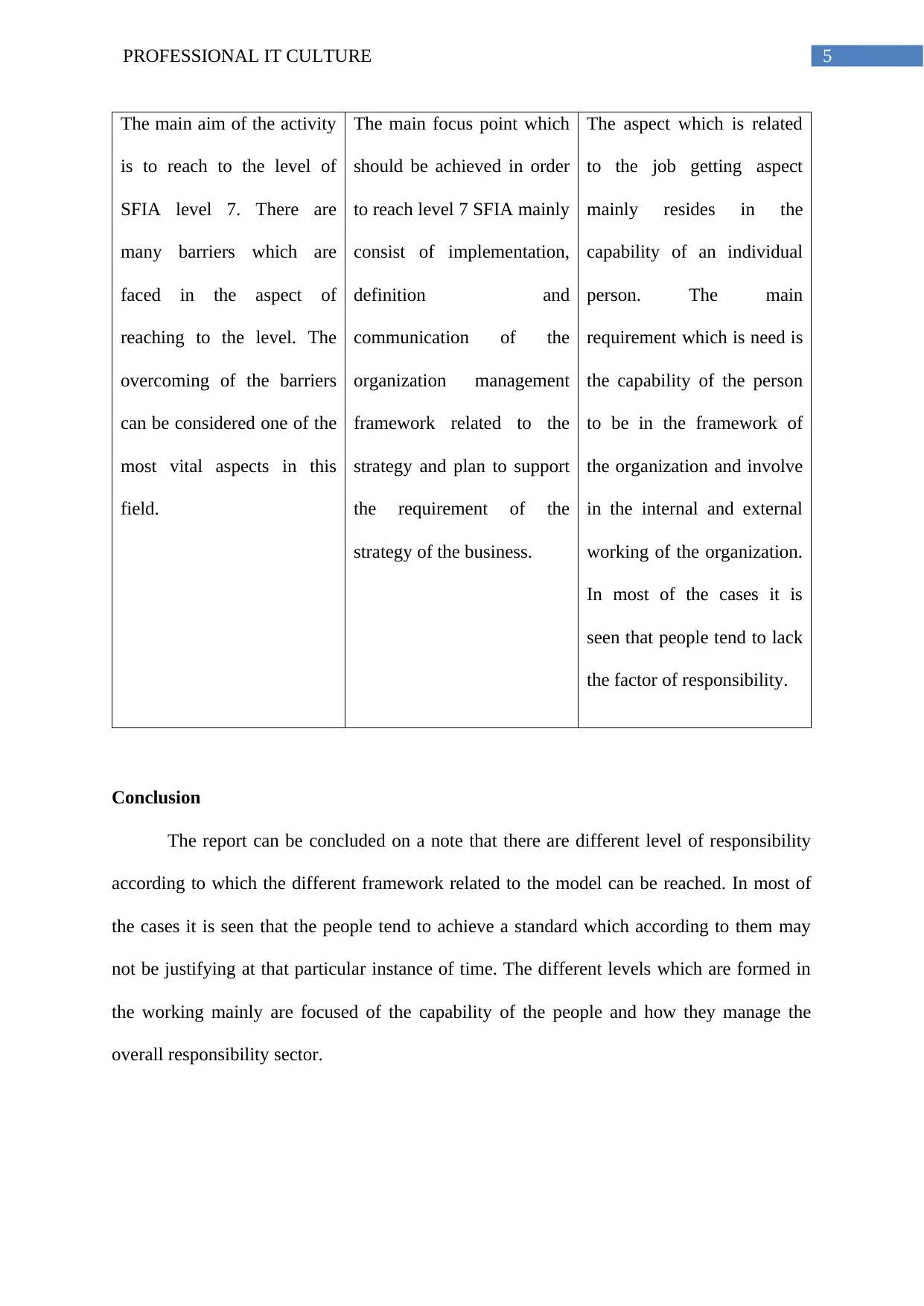
5PROFESSIONAL IT CULTURE
The main aim of the activity
is to reach to the level of
SFIA level 7. There are
many barriers which are
faced in the aspect of
reaching to the level. The
overcoming of the barriers
can be considered one of the
most vital aspects in this
field.
The main focus point which
should be achieved in order
to reach level 7 SFIA mainly
consist of implementation,
definition and
communication of the
organization management
framework related to the
strategy and plan to support
the requirement of the
strategy of the business.
The aspect which is related
to the job getting aspect
mainly resides in the
capability of an individual
person. The main
requirement which is need is
the capability of the person
to be in the framework of
the organization and involve
in the internal and external
working of the organization.
In most of the cases it is
seen that people tend to lack
the factor of responsibility.
Conclusion
The report can be concluded on a note that there are different level of responsibility
according to which the different framework related to the model can be reached. In most of
the cases it is seen that the people tend to achieve a standard which according to them may
not be justifying at that particular instance of time. The different levels which are formed in
the working mainly are focused of the capability of the people and how they manage the
overall responsibility sector.
The main aim of the activity
is to reach to the level of
SFIA level 7. There are
many barriers which are
faced in the aspect of
reaching to the level. The
overcoming of the barriers
can be considered one of the
most vital aspects in this
field.
The main focus point which
should be achieved in order
to reach level 7 SFIA mainly
consist of implementation,
definition and
communication of the
organization management
framework related to the
strategy and plan to support
the requirement of the
strategy of the business.
The aspect which is related
to the job getting aspect
mainly resides in the
capability of an individual
person. The main
requirement which is need is
the capability of the person
to be in the framework of
the organization and involve
in the internal and external
working of the organization.
In most of the cases it is
seen that people tend to lack
the factor of responsibility.
Conclusion
The report can be concluded on a note that there are different level of responsibility
according to which the different framework related to the model can be reached. In most of
the cases it is seen that the people tend to achieve a standard which according to them may
not be justifying at that particular instance of time. The different levels which are formed in
the working mainly are focused of the capability of the people and how they manage the
overall responsibility sector.
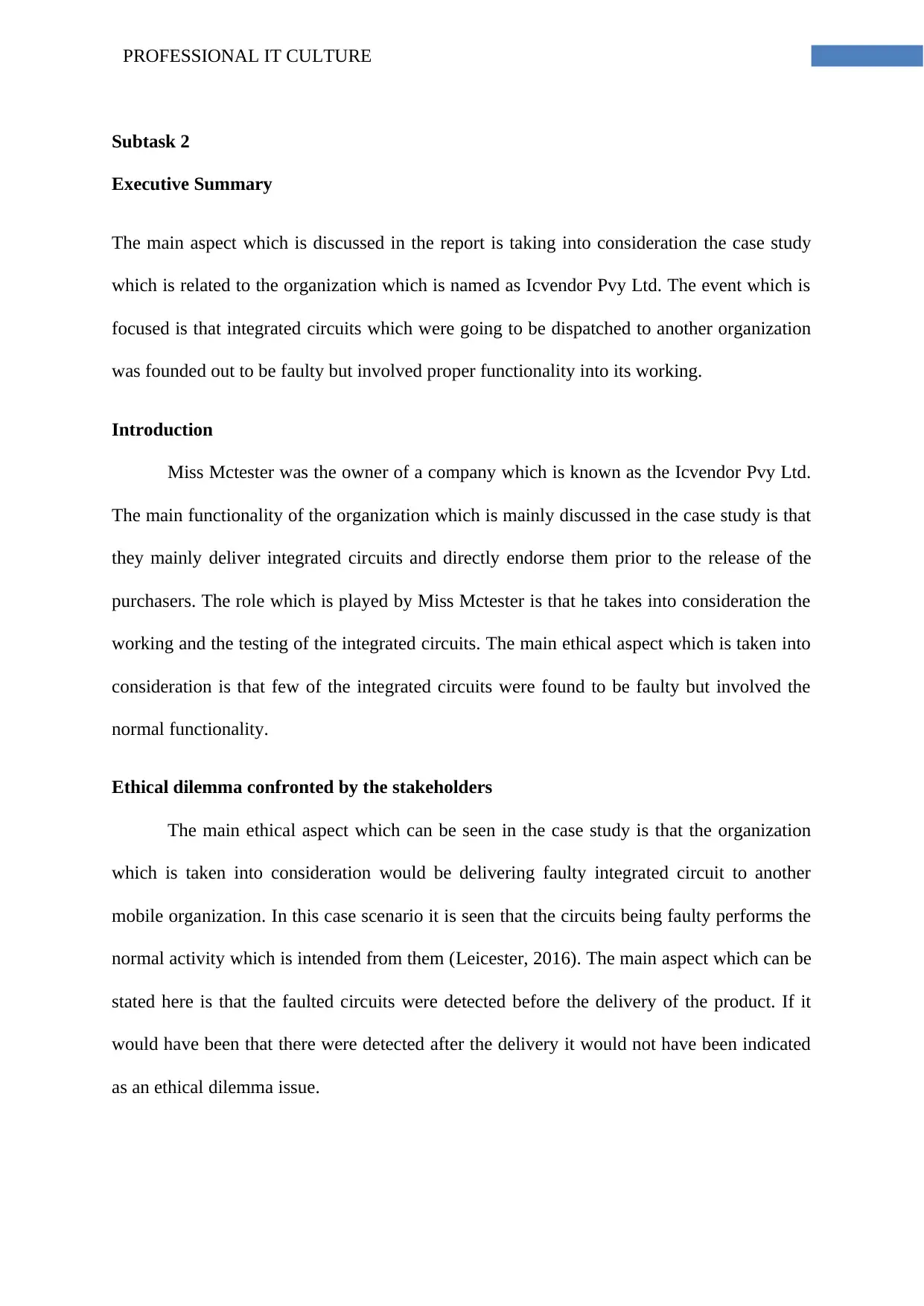
6PROFESSIONAL IT CULTURE
Subtask 2
Executive Summary
The main aspect which is discussed in the report is taking into consideration the case study
which is related to the organization which is named as Icvendor Pvy Ltd. The event which is
focused is that integrated circuits which were going to be dispatched to another organization
was founded out to be faulty but involved proper functionality into its working.
Introduction
Miss Mctester was the owner of a company which is known as the Icvendor Pvy Ltd.
The main functionality of the organization which is mainly discussed in the case study is that
they mainly deliver integrated circuits and directly endorse them prior to the release of the
purchasers. The role which is played by Miss Mctester is that he takes into consideration the
working and the testing of the integrated circuits. The main ethical aspect which is taken into
consideration is that few of the integrated circuits were found to be faulty but involved the
normal functionality.
Ethical dilemma confronted by the stakeholders
The main ethical aspect which can be seen in the case study is that the organization
which is taken into consideration would be delivering faulty integrated circuit to another
mobile organization. In this case scenario it is seen that the circuits being faulty performs the
normal activity which is intended from them (Leicester, 2016). The main aspect which can be
stated here is that the faulted circuits were detected before the delivery of the product. If it
would have been that there were detected after the delivery it would not have been indicated
as an ethical dilemma issue.
Subtask 2
Executive Summary
The main aspect which is discussed in the report is taking into consideration the case study
which is related to the organization which is named as Icvendor Pvy Ltd. The event which is
focused is that integrated circuits which were going to be dispatched to another organization
was founded out to be faulty but involved proper functionality into its working.
Introduction
Miss Mctester was the owner of a company which is known as the Icvendor Pvy Ltd.
The main functionality of the organization which is mainly discussed in the case study is that
they mainly deliver integrated circuits and directly endorse them prior to the release of the
purchasers. The role which is played by Miss Mctester is that he takes into consideration the
working and the testing of the integrated circuits. The main ethical aspect which is taken into
consideration is that few of the integrated circuits were found to be faulty but involved the
normal functionality.
Ethical dilemma confronted by the stakeholders
The main ethical aspect which can be seen in the case study is that the organization
which is taken into consideration would be delivering faulty integrated circuit to another
mobile organization. In this case scenario it is seen that the circuits being faulty performs the
normal activity which is intended from them (Leicester, 2016). The main aspect which can be
stated here is that the faulted circuits were detected before the delivery of the product. If it
would have been that there were detected after the delivery it would not have been indicated
as an ethical dilemma issue.
⊘ This is a preview!⊘
Do you want full access?
Subscribe today to unlock all pages.

Trusted by 1+ million students worldwide
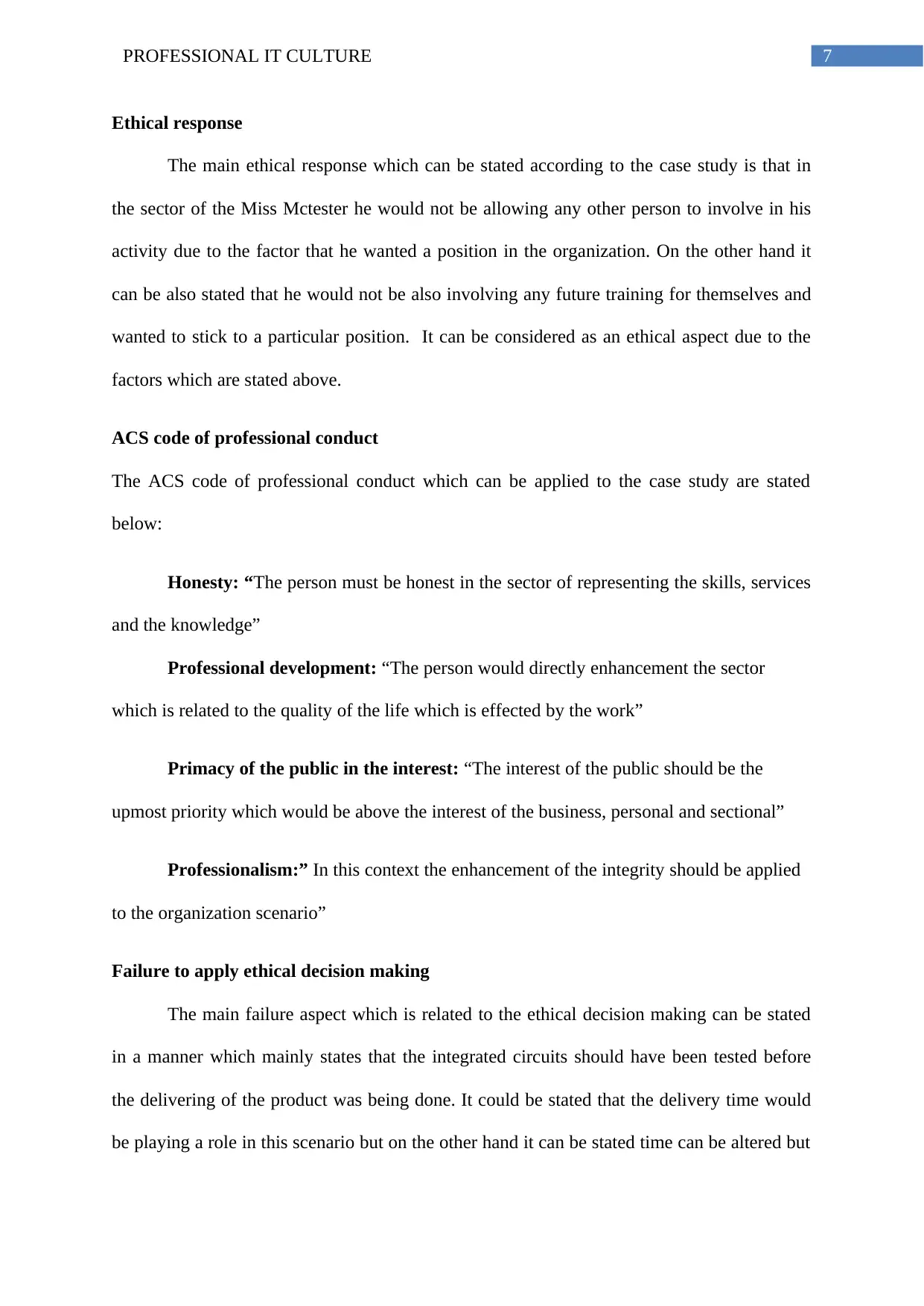
7PROFESSIONAL IT CULTURE
Ethical response
The main ethical response which can be stated according to the case study is that in
the sector of the Miss Mctester he would not be allowing any other person to involve in his
activity due to the factor that he wanted a position in the organization. On the other hand it
can be also stated that he would not be also involving any future training for themselves and
wanted to stick to a particular position. It can be considered as an ethical aspect due to the
factors which are stated above.
ACS code of professional conduct
The ACS code of professional conduct which can be applied to the case study are stated
below:
Honesty: “The person must be honest in the sector of representing the skills, services
and the knowledge”
Professional development: “The person would directly enhancement the sector
which is related to the quality of the life which is effected by the work”
Primacy of the public in the interest: “The interest of the public should be the
upmost priority which would be above the interest of the business, personal and sectional”
Professionalism:” In this context the enhancement of the integrity should be applied
to the organization scenario”
Failure to apply ethical decision making
The main failure aspect which is related to the ethical decision making can be stated
in a manner which mainly states that the integrated circuits should have been tested before
the delivering of the product was being done. It could be stated that the delivery time would
be playing a role in this scenario but on the other hand it can be stated time can be altered but
Ethical response
The main ethical response which can be stated according to the case study is that in
the sector of the Miss Mctester he would not be allowing any other person to involve in his
activity due to the factor that he wanted a position in the organization. On the other hand it
can be also stated that he would not be also involving any future training for themselves and
wanted to stick to a particular position. It can be considered as an ethical aspect due to the
factors which are stated above.
ACS code of professional conduct
The ACS code of professional conduct which can be applied to the case study are stated
below:
Honesty: “The person must be honest in the sector of representing the skills, services
and the knowledge”
Professional development: “The person would directly enhancement the sector
which is related to the quality of the life which is effected by the work”
Primacy of the public in the interest: “The interest of the public should be the
upmost priority which would be above the interest of the business, personal and sectional”
Professionalism:” In this context the enhancement of the integrity should be applied
to the organization scenario”
Failure to apply ethical decision making
The main failure aspect which is related to the ethical decision making can be stated
in a manner which mainly states that the integrated circuits should have been tested before
the delivering of the product was being done. It could be stated that the delivery time would
be playing a role in this scenario but on the other hand it can be stated time can be altered but
Paraphrase This Document
Need a fresh take? Get an instant paraphrase of this document with our AI Paraphraser
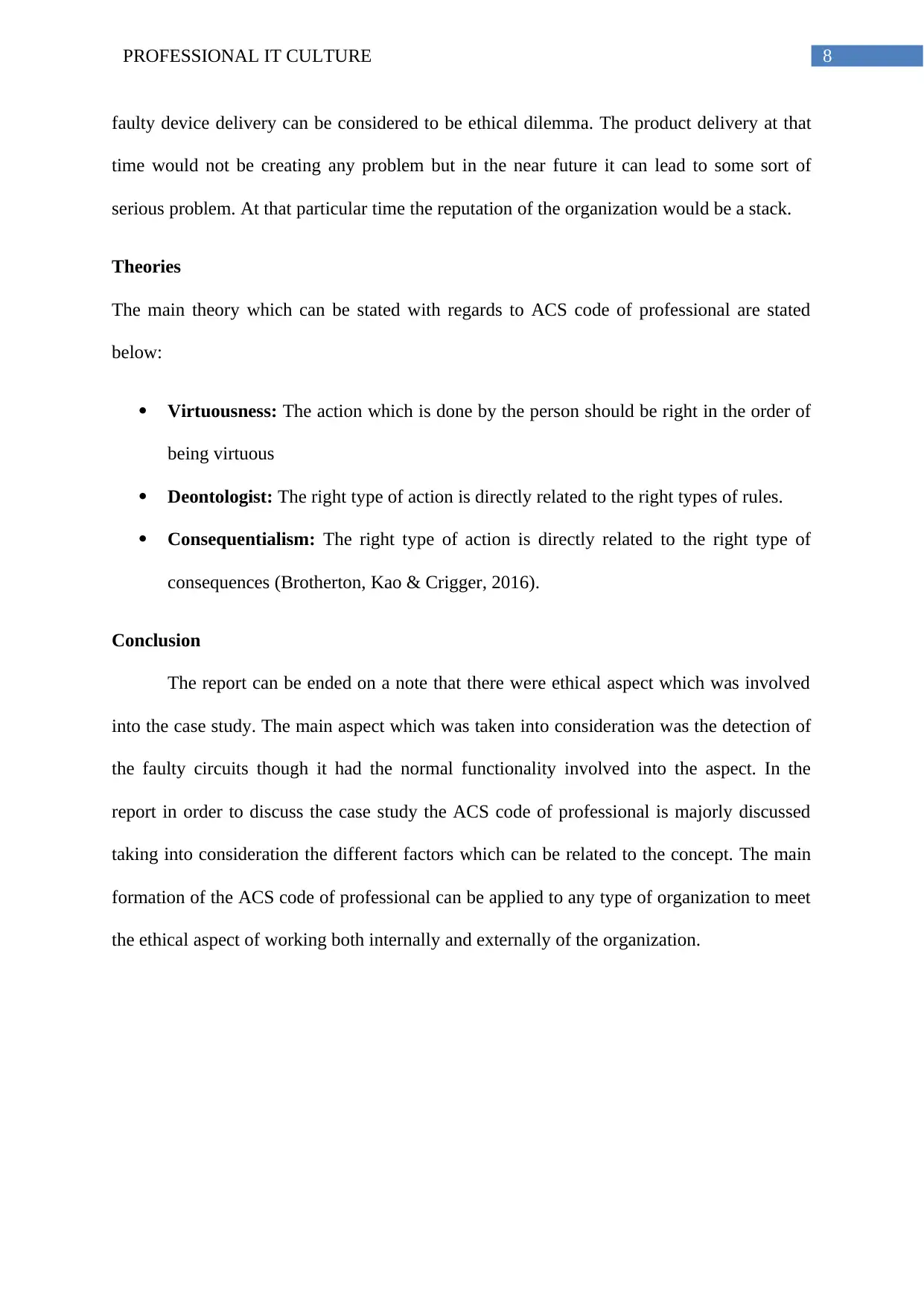
8PROFESSIONAL IT CULTURE
faulty device delivery can be considered to be ethical dilemma. The product delivery at that
time would not be creating any problem but in the near future it can lead to some sort of
serious problem. At that particular time the reputation of the organization would be a stack.
Theories
The main theory which can be stated with regards to ACS code of professional are stated
below:
Virtuousness: The action which is done by the person should be right in the order of
being virtuous
Deontologist: The right type of action is directly related to the right types of rules.
Consequentialism: The right type of action is directly related to the right type of
consequences (Brotherton, Kao & Crigger, 2016).
Conclusion
The report can be ended on a note that there were ethical aspect which was involved
into the case study. The main aspect which was taken into consideration was the detection of
the faulty circuits though it had the normal functionality involved into the aspect. In the
report in order to discuss the case study the ACS code of professional is majorly discussed
taking into consideration the different factors which can be related to the concept. The main
formation of the ACS code of professional can be applied to any type of organization to meet
the ethical aspect of working both internally and externally of the organization.
faulty device delivery can be considered to be ethical dilemma. The product delivery at that
time would not be creating any problem but in the near future it can lead to some sort of
serious problem. At that particular time the reputation of the organization would be a stack.
Theories
The main theory which can be stated with regards to ACS code of professional are stated
below:
Virtuousness: The action which is done by the person should be right in the order of
being virtuous
Deontologist: The right type of action is directly related to the right types of rules.
Consequentialism: The right type of action is directly related to the right type of
consequences (Brotherton, Kao & Crigger, 2016).
Conclusion
The report can be ended on a note that there were ethical aspect which was involved
into the case study. The main aspect which was taken into consideration was the detection of
the faulty circuits though it had the normal functionality involved into the aspect. In the
report in order to discuss the case study the ACS code of professional is majorly discussed
taking into consideration the different factors which can be related to the concept. The main
formation of the ACS code of professional can be applied to any type of organization to meet
the ethical aspect of working both internally and externally of the organization.
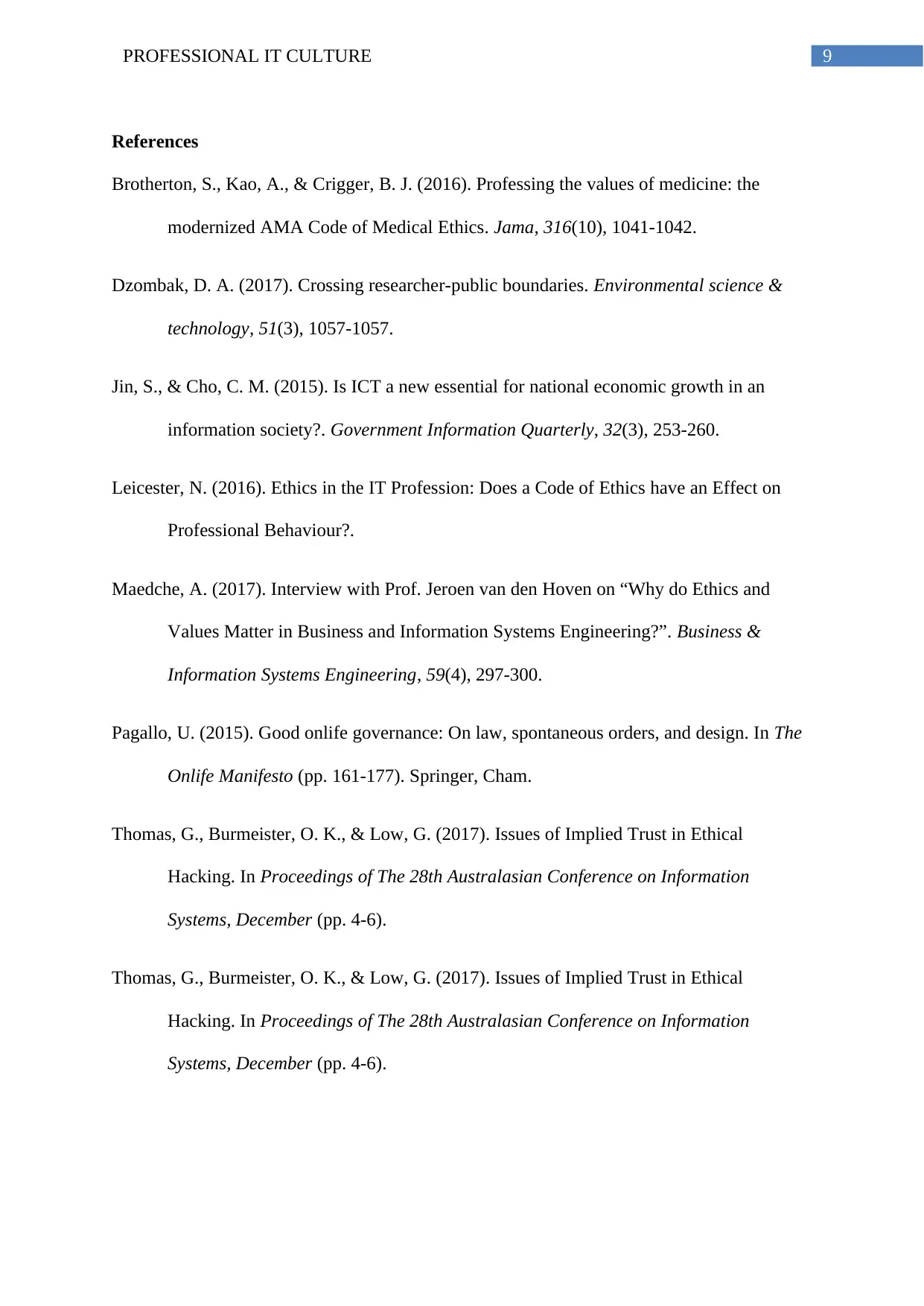
9PROFESSIONAL IT CULTURE
References
Brotherton, S., Kao, A., & Crigger, B. J. (2016). Professing the values of medicine: the
modernized AMA Code of Medical Ethics. Jama, 316(10), 1041-1042.
Dzombak, D. A. (2017). Crossing researcher-public boundaries. Environmental science &
technology, 51(3), 1057-1057.
Jin, S., & Cho, C. M. (2015). Is ICT a new essential for national economic growth in an
information society?. Government Information Quarterly, 32(3), 253-260.
Leicester, N. (2016). Ethics in the IT Profession: Does a Code of Ethics have an Effect on
Professional Behaviour?.
Maedche, A. (2017). Interview with Prof. Jeroen van den Hoven on “Why do Ethics and
Values Matter in Business and Information Systems Engineering?”. Business &
Information Systems Engineering, 59(4), 297-300.
Pagallo, U. (2015). Good onlife governance: On law, spontaneous orders, and design. In The
Onlife Manifesto (pp. 161-177). Springer, Cham.
Thomas, G., Burmeister, O. K., & Low, G. (2017). Issues of Implied Trust in Ethical
Hacking. In Proceedings of The 28th Australasian Conference on Information
Systems, December (pp. 4-6).
Thomas, G., Burmeister, O. K., & Low, G. (2017). Issues of Implied Trust in Ethical
Hacking. In Proceedings of The 28th Australasian Conference on Information
Systems, December (pp. 4-6).
References
Brotherton, S., Kao, A., & Crigger, B. J. (2016). Professing the values of medicine: the
modernized AMA Code of Medical Ethics. Jama, 316(10), 1041-1042.
Dzombak, D. A. (2017). Crossing researcher-public boundaries. Environmental science &
technology, 51(3), 1057-1057.
Jin, S., & Cho, C. M. (2015). Is ICT a new essential for national economic growth in an
information society?. Government Information Quarterly, 32(3), 253-260.
Leicester, N. (2016). Ethics in the IT Profession: Does a Code of Ethics have an Effect on
Professional Behaviour?.
Maedche, A. (2017). Interview with Prof. Jeroen van den Hoven on “Why do Ethics and
Values Matter in Business and Information Systems Engineering?”. Business &
Information Systems Engineering, 59(4), 297-300.
Pagallo, U. (2015). Good onlife governance: On law, spontaneous orders, and design. In The
Onlife Manifesto (pp. 161-177). Springer, Cham.
Thomas, G., Burmeister, O. K., & Low, G. (2017). Issues of Implied Trust in Ethical
Hacking. In Proceedings of The 28th Australasian Conference on Information
Systems, December (pp. 4-6).
Thomas, G., Burmeister, O. K., & Low, G. (2017). Issues of Implied Trust in Ethical
Hacking. In Proceedings of The 28th Australasian Conference on Information
Systems, December (pp. 4-6).
⊘ This is a preview!⊘
Do you want full access?
Subscribe today to unlock all pages.

Trusted by 1+ million students worldwide
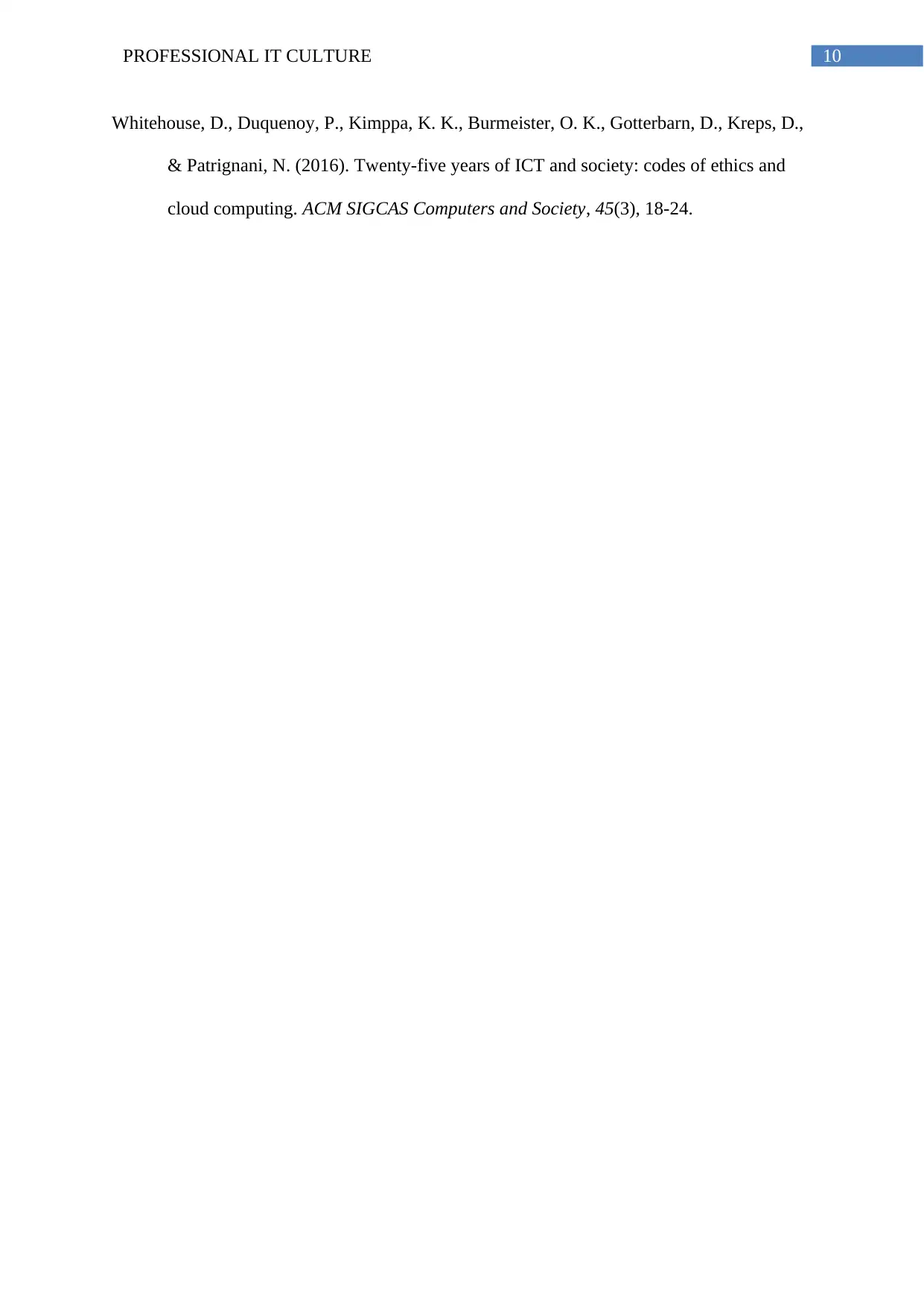
10PROFESSIONAL IT CULTURE
Whitehouse, D., Duquenoy, P., Kimppa, K. K., Burmeister, O. K., Gotterbarn, D., Kreps, D.,
& Patrignani, N. (2016). Twenty-five years of ICT and society: codes of ethics and
cloud computing. ACM SIGCAS Computers and Society, 45(3), 18-24.
Whitehouse, D., Duquenoy, P., Kimppa, K. K., Burmeister, O. K., Gotterbarn, D., Kreps, D.,
& Patrignani, N. (2016). Twenty-five years of ICT and society: codes of ethics and
cloud computing. ACM SIGCAS Computers and Society, 45(3), 18-24.
1 out of 10
Related Documents
Your All-in-One AI-Powered Toolkit for Academic Success.
+13062052269
info@desklib.com
Available 24*7 on WhatsApp / Email
![[object Object]](/_next/static/media/star-bottom.7253800d.svg)
Unlock your academic potential
Copyright © 2020–2025 A2Z Services. All Rights Reserved. Developed and managed by ZUCOL.





